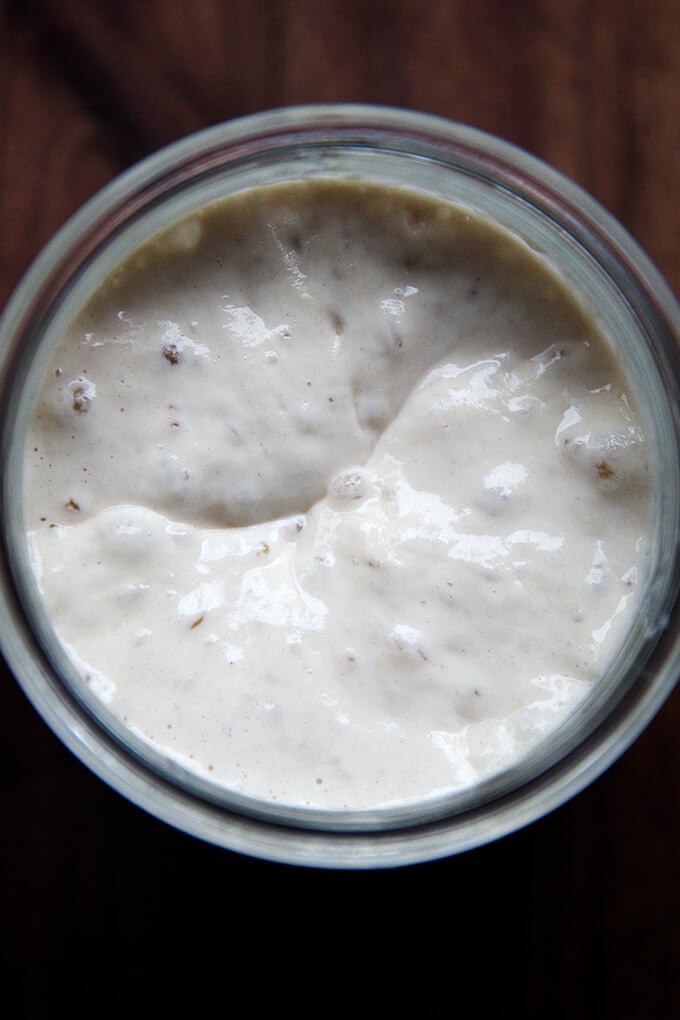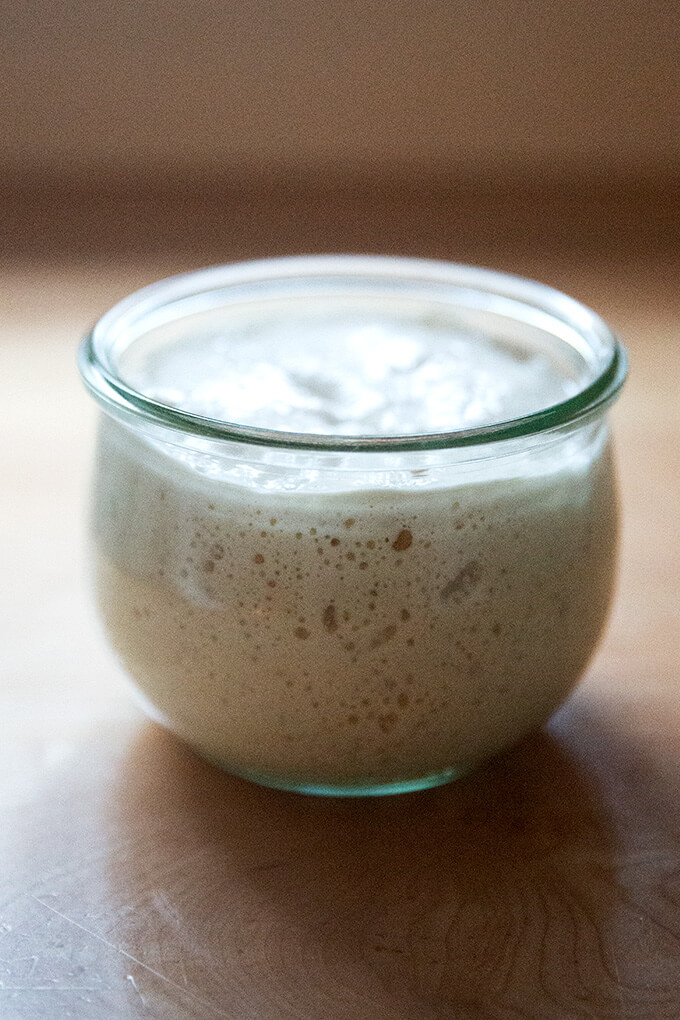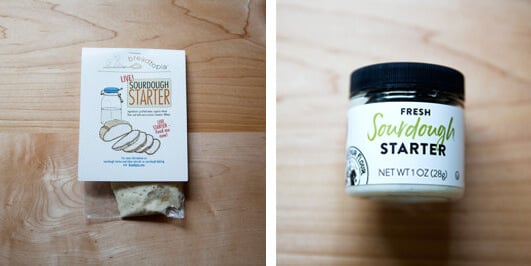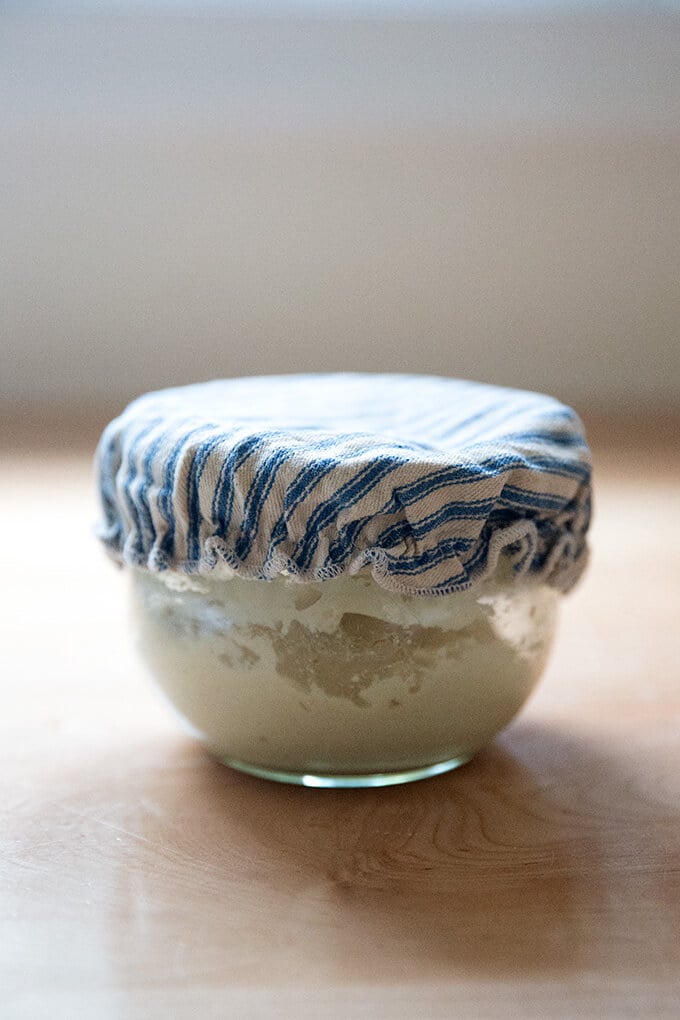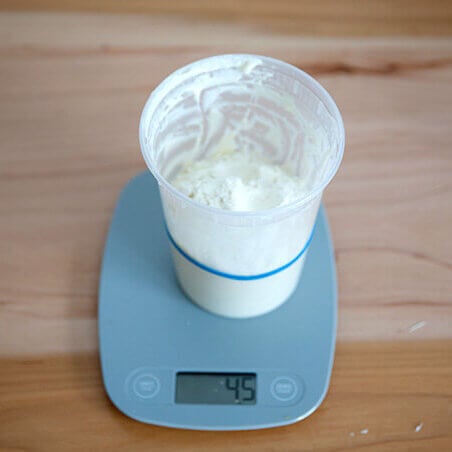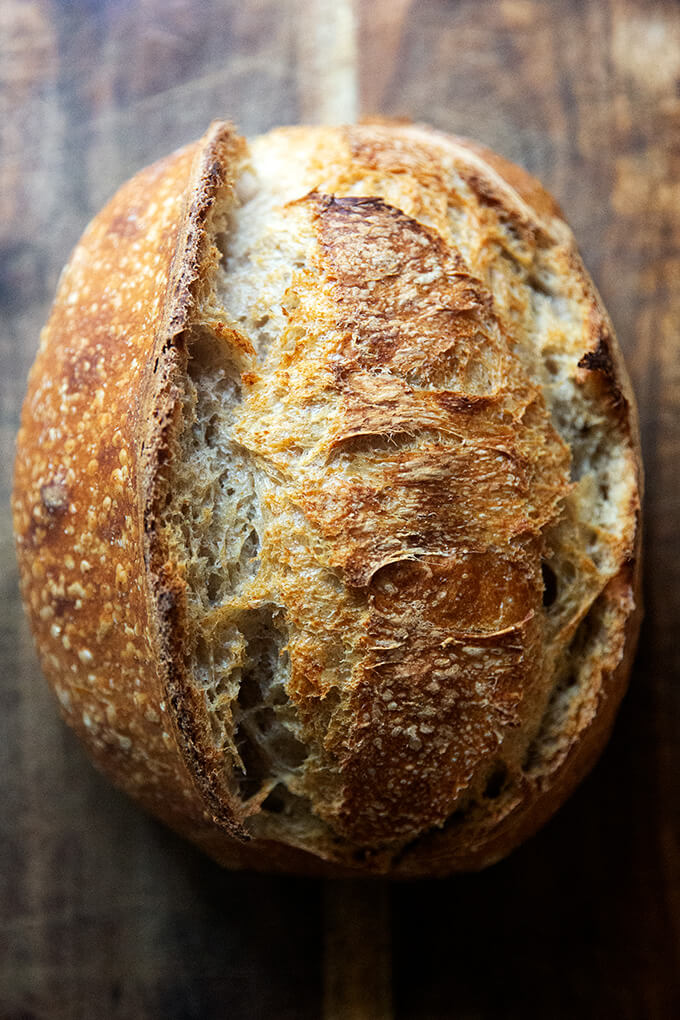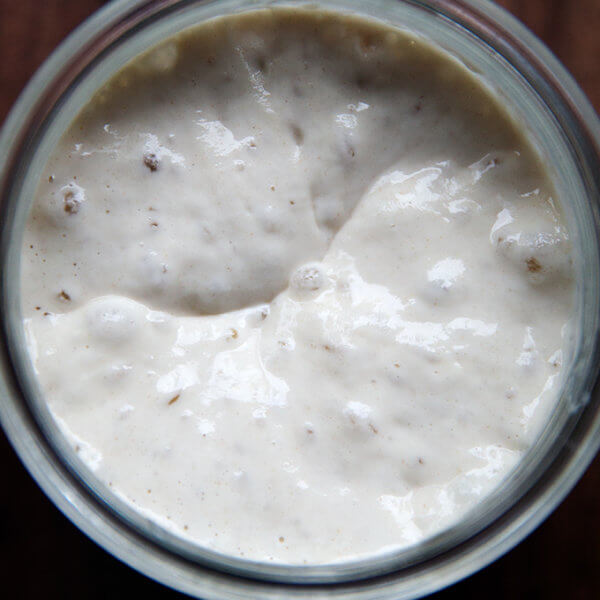If you are interested in dipping your toe into sourdough bread baking, for starters you need a starter (😂). In this sourdough starter guide I share my tips for:
Buying a sourdough starter online Activating a sourdough starter Feeding a sourdough starter Maintaining a sourdough starter Storing a sourdough starter Knowing when a sourdough starter is bad How to use your discard in delicious recipes
Although building a sourdough starter from scratch is very gratifying, I am a huge proponent of purchasing a starter. I outline why in more detail here — Sourdough Focaccia: A Beginner’s Guide — but in short, it’s because:
If you’re curious about sourdough, get to it! Making a starter from scratch can take weeks. They’re relatively cheap (or free if you get one from a friend or baker). A purchased starter potentially will be stronger/more active than a young, homemade starter. Before you spend weeks making a starter, find out if you like the process — again, a purchased starter allows you to get straight to it.
Where to Purchase a Sourdough Starter
I have had success purchasing and activating sourdough starters from three places:
Breadtopia ($9) King Arthur Flour ($9) Cultures for Health ($11)
Each place offers guidance for “activating” the starter. Breadtopia’s instructions live on its website. King Arthur Flour sends along a booklet with details, but also provides online help. Cultures For Health offers video guidance here. In short, to “activate” each, you simply add flour and water, stir, and wait — that’s all there is to feeding a sourdough starter.
How to Activate a Sourdough Starter
A purchased starter generally arrives in a small bag or container. I’ve created a short video for activating a King Arthur Flour sourdough starter. You can use this same process for activating a Breadtopia starter as well: Follow these steps to activate it:
How to Feed A Sourdough Starter
If your starter floats, and you’re ready to start baking, measure the required amount into a bowl and proceed with the recipe. Here are four great beginner’s sourdough recipes: If you’re not ready to bake, discard most of it, add an equal amount of flour and water (45 g each or so), stir it together, cover it, and stash in your fridge. My preferred storage vessel is a deli quart container. When I store my starter in the fridge, I use the lid that comes with the quart container. When I feed my starter and let it sit at room temperature, I use a breathable lid. From here on out, you’ll need to feed it roughly once every two weeks — I’ve left it for as long as three-four weeks without a feeding, and it has been fine, but I don’t recommend waiting that long in between feedings. Here’s the play-by-play:
- Place the vessel holding your starter on a scale, and add 45 g flour:
- Add 45 g water:
- Stir together and mark the top of the mixture with a rubber band:
- Wait until the starter doubles or nearly doubles:
- Test it! If it floats, you’re good to go! Before long, you’ll get the hang of your starter’s rhythm: how it rises and falls, how it behaves when you feed it more regularly, how it behaves when you neglect it, how it smells at various stages, etc. When you’re ready to bake, the goal is to “catch” the starter at its peak (i.e. at its doubling point, when you see lots of bubbles covering the surface) — this is when it is the strongest/most alive. If you miss the opportunity, and the starter collapses, don’t despair: simply discard some of it (or don’t), and feed it again with equal parts flour and water by weight, stir, and set it aside to rise again.
Maintaining a Sourdough Starter
Something that deterred me from sourdough for a long time is the waste element: I hated discarding so much and “feeding” so much. I’ve learned over time that there are ways to keep your starter on the lean side to reduce the waste factor. Here’s how: After I use my starter for a bread recipe, I do one of two things: If there is a fair amount of starter left (a half cup or 100 g), I simply stir it up, cover it, and stash it in the fridge. If there are only a few tablespoons of starter left, I like to replenish it with a very small amount of flour and water (45 g of each). Once I add the flour and water and stir it all together, I cover the vessel, and stash it in the fridge. Every time I use it or feed it, I discard most of it, and feed it with equal amounts by weight water and flour. When life gets in the way, and I can’t find time for sourdough, I tend to it every 2-3 weeks by discarding most of it, and feeding it with 45 g each flour and water.
Storing a Sourdough Starter
If you are not baking regularly, store your starter in the fridge. As noted above, my preferred storage vessel is a deli quart container. When I store my starter in the fridge, I use the lid that comes with the quart container. When I feed my starter and let it sit at room temperature, I use a breathable lid. Ideally, strive to feed your starter roughly once a week or every two weeks if you are not finding time to bake regularly. If you are baking regularly, feeding your starter once a week will be a natural part of your baking rhythm. If you are looking for ideas for what to do with the discard, try these sourdough flour tortillas, this Irish soda bread, these pancakes or make peasant bread as outlined in this troubleshooting post. As noted above, I’ve left my starter for as long as three to four weeks in the fridge without feeding it, and it has “awakened” beautifully, though I don’t recommend, if you can help it, waiting that long in between feedings.
How to Tell if Your Starter is Healthy
If you are just getting started with sourdough, it may be hard to “read” the various smells of your starter. Depending on what “phase” a starter is in — i.e. freshly fed or neglected for weeks in the fridge — it can smell anywhere from stinky and acidic to fresh and sweet. Don’t be alarmed if your starter, upon pulling it from the fridge, smells a little funky. It might smell like alcohol or, as one commenter noted: dirty socks. As soon as you discard most of this sharp-smelling starter and feed it with equal parts flour and water, the aroma will instantly change. As your starter rises and approaches a doubling point, it should smell fresh and sweet. You know you have a healthy starter when it … So how do you know if your starter is bad? When … Unfortunately, if you see mold in your starter, you probably should toss it, and start over. Alternatively, you could scrape off the moldy bits, transfer a few tablespoons of what looks healthy (not moldy) to a clean jar, and feed it with equal parts flour and water. If your starter is not doubling in volume within 4 to 6 hours of a feeding you should spend a few days strengthening it. This is what I always recommend:
Be aggressive with how much of it you are discarding: throw away most of it, leaving behind just 2 tablespoons or so. Feed it with equal parts by weight flour and water. Start with 40 g of each or so. Use water that you’ve left out overnight to ensure any chlorine has evaporated. (This isn’t always necessary, but it might make a difference.) Buy spring or distilled water. In some places, letting water sit out overnight will not be effective, and your tap water may kill your starter. Feed your starter with organic flour or a small amount of rye flour or stone-milled flour (fresh or locally milled if possible). My store sells 2-lb. bags of King Arthur Flour organic all-purpose flour for $3.49 — I use it exclusively for feeding my starter. Once you feed your starter, cover the vessel with a breathable lid, and leave it alone at room temperature. After 6 hours (more or less), repeat the process: discard most of it and feed it with 40 g each flour and water.
Once you have a strong starter on hand — one that is doubling in volume within 4 to 6 hours — you can bake with it (using it at its peak doubling point) or stash it in the fridge. When you feed your starter, place a rubber band around the vessel to mark the starter’s height, which helps gauge when it has doubled
Sourdough Discard Recipes
Though I generally keep a small starter (as outlined above), inevitably I end up with sourdough discard on my hands due to the nature of the sourdough starter feeding process. And when I am organized, I put that discard to delicious use. Here are four simple recipes calling for sourdough discard:
Simple Sourdough Discard Crackers (Pictured above.) Sourdough Tortillas Favorite Pancakes Irish Soda Bread
Questions? Thoughts? Shoot! 5 from 25 reviews
Where to Buy a Sourdough Starter
I have had success purchasing and activating sourdough starters from three places:
Breadtopia ($9) King Arthur Flour ($9) Cultures for Health ($11)
As with all sourdough bread baking (and all baking in general), you will have the best results if you measure with a digital scale. The amount of starter you start with is not really important here. What is important is that you feed your starter with equal parts by weight flour and water — this is called a 100% hydration starter, and it is what many sourdough bread recipes, including all of the ones on this site, call for.
Flour
If you can find King Arthur Flour organic all-purpose flour at your local supermarket, buy that. Organic flour or a little bit of freshly milled flour will help your starter thrive.
Water
I always use tap water that I’ve left to sit out overnight, which ensures any chlorine has evaporated. In some places, letting water sit out overnight will not be effective, and your tap water may kill your starter. If you are unsure about your water, consider buying a gallon of spring water to use exclusively for feeding your starter until you get the hang of the process.
To Feed Your Sourdough Starter: How to Maintain Your Sourdough Starter:
Add 45 g water:
Stir together and mark the top of the mixture with a rubber band:
Wait until the starter doubles or nearly doubles:
Test it! If it floats, you’re good to go!
To Store Your Sourdough Starter
If you are not baking regularly, store your starter in the fridge. My preferred storage vessel is a deli quart container. When I store my starter in the fridge, I use the lid that comes with the quart container. When I feed my starter and let it sit at room temperature, I use a breathable lid.
Ideally, strive to feed your starter roughly once a week or every two weeks if you are not finding time to bake regularly. If you are baking regularly, feeding your starter once a week will be a natural part of your baking rhythm. If you are looking for ideas for what to do with the discard, try these sourdough flour tortillas or make peasant bread as outlined in this troubleshooting post.
Note: I’ve left my starter for as long as three to four weeks in the fridge without feeding it, and it has “awakened” beautifully, though I don’t recommend, if you can help it, waiting that long in between feedings.
